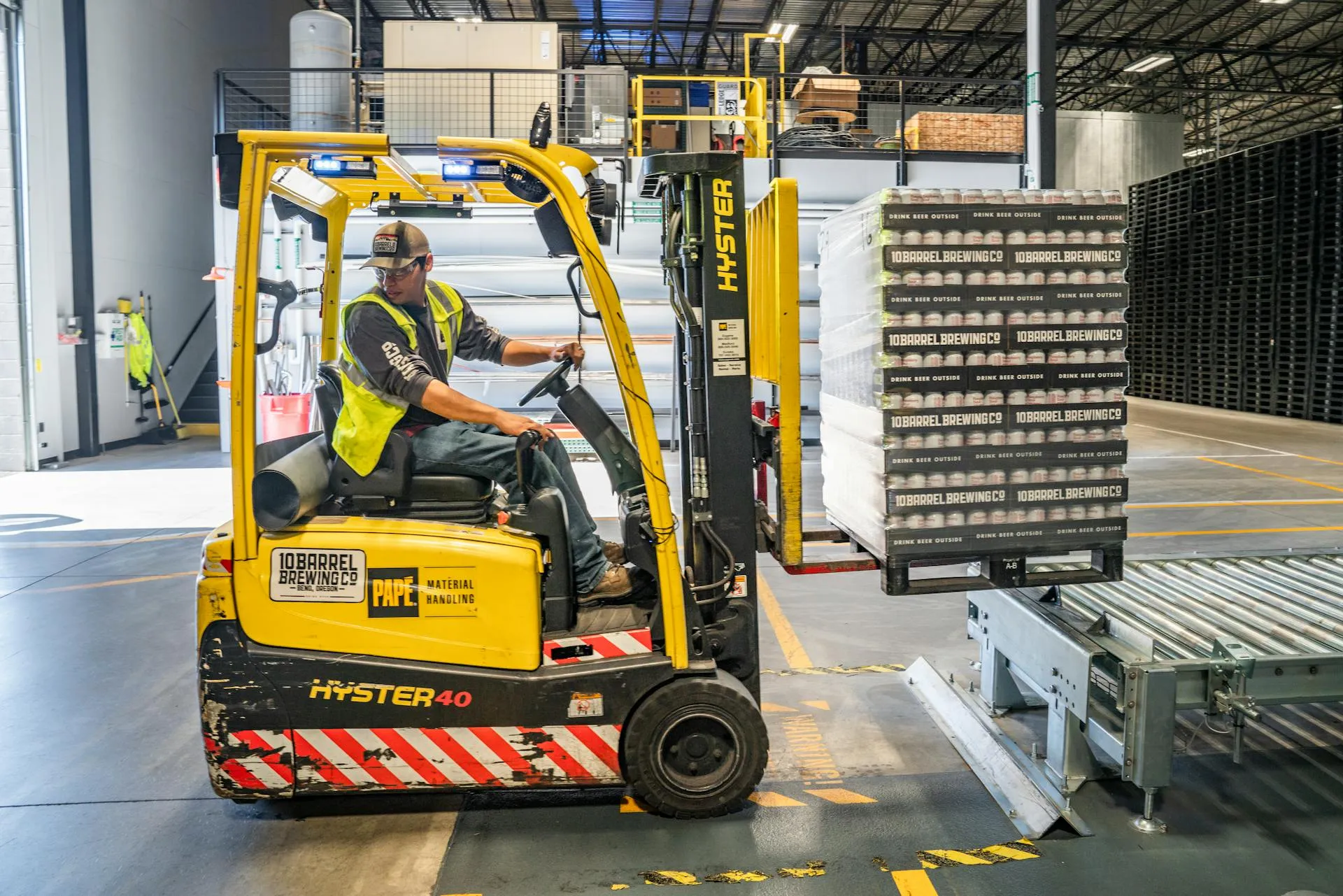For many enterprises, existing systems have become a double-edged sword. They are essential to daily operations yet increasingly burdensome. What once served as a competitive edge now acts as a drag on agility, innovation, and growth. Legacy infrastructures often can’t support modern business requirements: seamless integrations, omnichannel service delivery, real-time data access, and scalable digital offerings.
Companies that cling to outdated platforms risk falling behind competitors who are embracing modern systems built on cloud native architectures and designed to enable continuous innovation. The pressure is mounting to improve customer experience, unlock operational efficiency, and reduce mounting technical debt.
This is where legacy systems modernization comes into the equation. Modernizing aging platforms is all about transforming business processes, enabling better customer experiences, and aligning IT capabilities with long-term strategic goals. This article will explore what modernization really means, its benefits, common pitfalls, and how platforms like Salesforce can accelerate your path toward digital transformation.
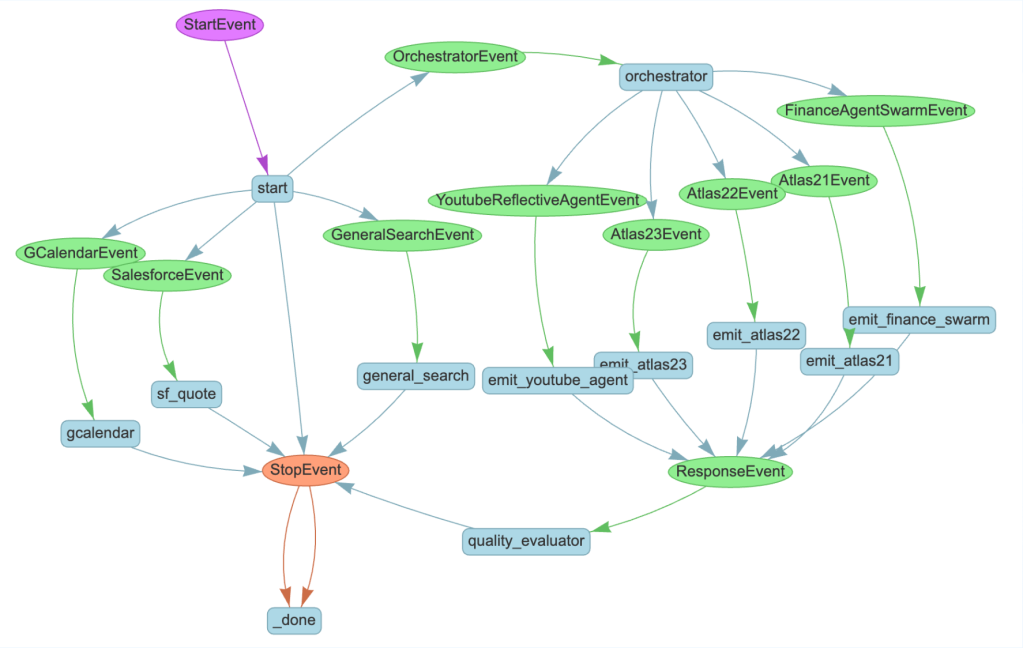
What is Legacy Systems Modernization?
Legacy systems modernization is the process of updating or transforming outdated technology environments to meet today’s business needs. These systems often run on old code, rely on aging infrastructure, or were built in a time when integration, scalability, and user experience weren’t core priorities. While they may still function, they often limit an organization’s ability to innovate, scale, or deliver high-quality customer experiences.
In most cases, modernization doesn’t require a full system replacement. It’s often a strategic effort to enhance or re-architect existing systems so they can integrate with modern technologies and support long-term business growth. That could mean migrating to the cloud, building API connections, or replacing individual components with cloud native solutions.
Common signs that a system is ready for modernization include:
- Outdated technology that lacks vendor support or compatibility with newer tools
- Inefficient performance that slows down operations or frustrates users
- Security vulnerabilities that expose the business to compliance and data risks
- High maintenance costs due to aging infrastructure and manual upkeep
- Limited scalability that makes it difficult to support growth or spikes in demand
- Poor adaptability to new business requirements, customer needs, or market changes
System modernization gives businesses a way to improve efficiency, reduce risk, and align their technology stack with evolving expectations. It also provides a more agile foundation for digital transformation and continuous innovation.
Why Modernize? The Business and Technical Benefits
Modernizing legacy systems is a strategic move that helps organizations stay competitive and meet growing customer demands to unlock long-term value. As technology evolves, relying on outdated infrastructure puts pressure on both IT teams and business leaders to deliver results with tools that weren’t built for today’s pace.
One of the most compelling reasons to modernize is the impact it has on efficiency. Older systems tend to require workarounds, manual processes, and siloed data, which slows down decision-making. By shifting to modern systems that are built for integration and automation, teams can streamline business processes, reduce redundancy, and make better use of resources.
Modernization also plays a critical role in enhancing customer experiences. Customers expect fast, seamless interactions across channels, and legacy applications often can’t keep up. A modern technology stack improves speed, personalization, and consistency—factors that directly influence retention and satisfaction.
Some of the most common benefits of modernizing legacy systems include:
- Improved data accessibility and real-time visibility across departments
- Stronger security measures to reduce risk and maintain compliance
- Lower maintenance costs due to reduced reliance on legacy infrastructure
- Increased agility to adapt to changing business requirements
- Better user experience for both employees and customers
- Greater readiness for digital transformation initiatives
- Enhanced ability to support AI, automation, and other modern technologies
The sooner organizations invest in legacy systems modernization efforts, the faster they can reduce technical debt and create a foundation that supports long-term innovation.
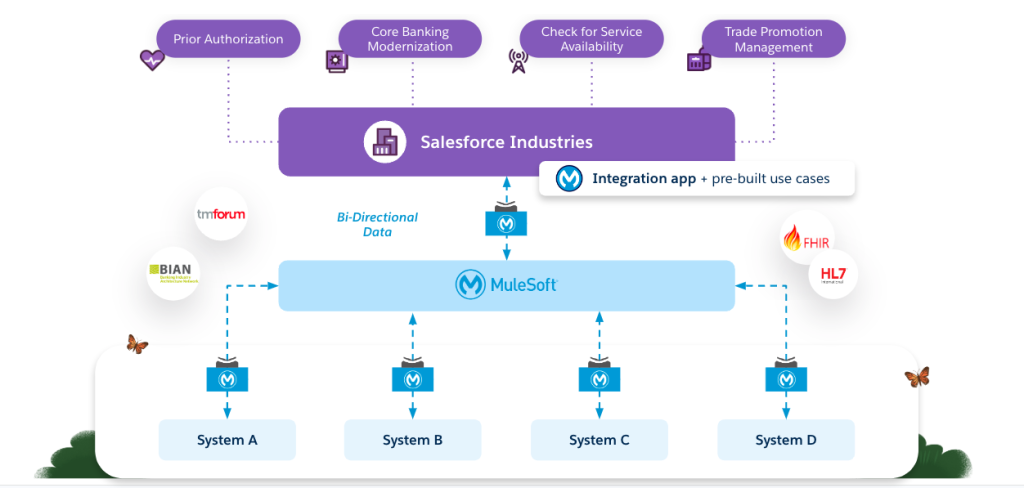
Modernization Strategies: Actionable Paths with Salesforce
These are some of the proven strategies for modernizing legacy applications using Salesforce and its ecosystem. Each approach is tailored to different business requirements, system complexity, and modernization goals. Research and industry data support how these strategies reduce technical debt and accelerate outcomes.
1. Incremental Integration using MuleSoft
Many organizations face tightly coupled systems and integration challenges when trying to modernize without disrupting existing operations. MuleSoft enables incremental modernization by abstracting legacy applications behind APIs.
- According to the MuleSoft 2020 State of Business and IT Innovation report, only 37% of organizations say they have the skills and technology to keep pace with digital projects. Yet 82% of business users agree that easy access to data and systems is essential for productivity.
- The 2021 Connectivity Benchmark Report from MuleSoft shows that enterprises spend on average $3.5 million a year on custom integration labor, and 90% still struggle with data silos.
- Using MuleSoft to build reusable APIs not only improves speed to market but also reduces long-term development costs and integration friction.
Related Article: Cloud Integration Solutions with MuleSoft & Agentforce
2. Replatforming Front‑End with Salesforce Lightning
Migrating user interfaces and experience layers to Salesforce Lightning can modernize user experience while the back‑end remains in place, reducing risk and cost.
- Organizations can achieve a higher return on investment over time by deploying Lightning for Sales Cloud. Productivity improves by up to 25% and time‑to‑market for applications was cut nearly in half.
- Organizations also benefited from more intuitive user interfaces, improved efficiency, and developer cost savings.
Converting to Lightning also lowers technical debt by reducing reliance on legacy code and enabling faster, modular app development.
Related Article: Salesforce Technical Debt (and How to Avoid It)
3. Migrating Business Processes to Cloud Native Services
Beyond UI and integration, true modernization often means moving business processes into cloud native environments provided by Salesforce:
- Salesforce Customer 360 unifies data and interactions across Sales, Service, Marketing and Commerce Clouds to eliminate data silos and improve collaboration across departments.
- A 2022 survey by Salesforce showed average IT cost savings of 25% and a 26% gain in employee productivity after consolidating systems onto Customer 360.
These cloud native platforms support scalable and secure automation, better business requirements alignment, and stronger insights across data sources.
4. Greenfield Application Development on Salesforce Platform
For organizations with outdated or highly customized enterprise applications, rebuilding select functionality using Salesforce’s extensible platform may be the best long‑term path.
- Salesforce Platform enables low‑code or pro‑code development of custom applications aligned with business needs. It supports real‑time data, AI, automation, and workflow orchestration.
- Migrating from monolithic legacy apps to modular microservices can reduce technical debt over time. Despite an initial spike, the rate of debt growth slows, improving system health in the long term.
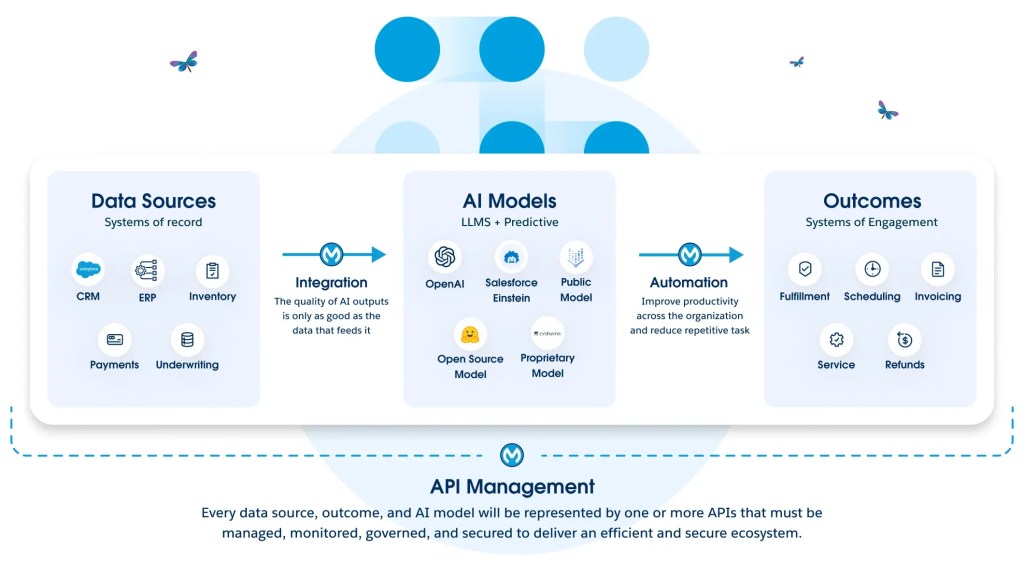
Why Salesforce is the Modernization Platform of Choice
Salesforce has evolved into much more than a CRM. It is the modernization platform enterprises rely on to simplify digital transformation and build scalable, agile systems. At its core, Salesforce is a cloud-native platform designed to handle enterprise demands for speed and flexibility. Its low-code capabilities enable both IT teams and business users to rapidly create, customize, and deploy applications, cutting down the time and cost typically associated with modernization projects.
Data unification is a critical advantage that sets Salesforce apart. Through Salesforce Data Cloud, organizations gain a single source of truth by breaking down data silos across systems. This unified data foundation drives smarter decisions and delivers seamless customer experiences. Alongside this, Salesforce’s integration power through MuleSoft connects legacy applications, APIs, and cloud solutions, creating a fully interoperable IT ecosystem without costly rewrites.
Related Article: Hire Salesforce Integration Services for Streamlined Growth
The platform is also AI-native, embedding tools like Agentforce for real-time insights, predictive analytics, and automation. These features enable businesses to automate routine tasks and unlock new growth opportunities. Additionally, Salesforce’s extensive ecosystem offers a wide range of options for customization and industry-specific solutions through AppExchange, a broad partner network, and specialized industry clouds.
Key capabilities of Salesforce as a modernization platform include:
- Cloud-native infrastructure built for scale and performance
- Low-code development that accelerates app delivery
- Salesforce Data Cloud for comprehensive data unification
- MuleSoft-powered integration connecting legacy and modern systems
- Built-in AI with Agentforce for predictive analytics and automation
- Ecosystem extensibility via AppExchange and industry clouds
This combination creates a powerful foundation for enterprise modernization to reduce complexity, accelerate delivery, and future-proof your technology investments.
Common Pitfalls (and How to Avoid Them)
Legacy systems modernization is a complex journey. Many organizations stumble not because of technology, but due to avoidable missteps that derail progress and inflate costs. Understanding these pitfalls upfront can save time and resources while increasing the likelihood of success.
Common Challenges
- Lack of executive alignment or unclear key performance indicators (KPIs). Without leadership buy-in and measurable goals, modernization initiatives lose focus and momentum.
- Underestimating the complexity of data migration. Legacy data often resides in inconsistent formats and multiple systems, creating unforeseen challenges that can stall projects.
- Attempting a full rip-and-replace approach without a phased roadmap. Trying to overhaul everything at once increases risk and disrupts business continuity.
- Failing to involve end-users and neglecting change management. User adoption suffers when the people who rely on these systems are excluded from the process early on.
Avoid these pitfalls with proven strategies
- Develop a clear modernization roadmap or business capability model. This aligns stakeholders, defines priorities, and creates realistic timelines.
- Use MuleSoft to enable staged integrations. This allows gradual system modernization while maintaining stable operations.
- Pilot small wins with Salesforce clouds to build momentum and demonstrate value. Early successes help secure continued executive support and user buy-in.
- Invest in change management from day one. Engage end-users, communicate transparently, and provide training to ensure smooth transitions.
Related Article: The Ultimate Salesforce Implementation Checklist
Building the Business Case for Modernization
Securing internal support for legacy system modernization requires a compelling business case that resonates with decision-makers. It’s about quantifiable business impact and alignment with strategic goals.
Start by calculating the cost of maintaining the status quo. This includes the financial drag of technical debt, operational inefficiencies, and missed revenue opportunities due to slow processes or poor customer experiences. Quantifying these hidden costs creates urgency and frames modernization as a necessary investment rather than discretionary spending.
Next, tie your modernization efforts directly to business objectives. Whether it’s accelerating growth, improving customer retention, or ensuring compliance with evolving regulations, connect the dots clearly for stakeholders. Demonstrate how modernization enables these outcomes through enhanced agility, data-driven insights, and streamlined processes.
Showcase both quick wins and long-term value. Early successes build confidence and maintain momentum, while a clear roadmap illustrates sustainable benefits over time. This balanced approach helps address concerns about disruption and justifies ongoing investment.
Finally, align your modernization initiative with broader digital transformation goals and industry trends. Position it as a critical step toward future readiness, competitive advantage, and innovation capacity.
Related Article: CRM Implementation Services Explained: Strategy, Cost, & Value
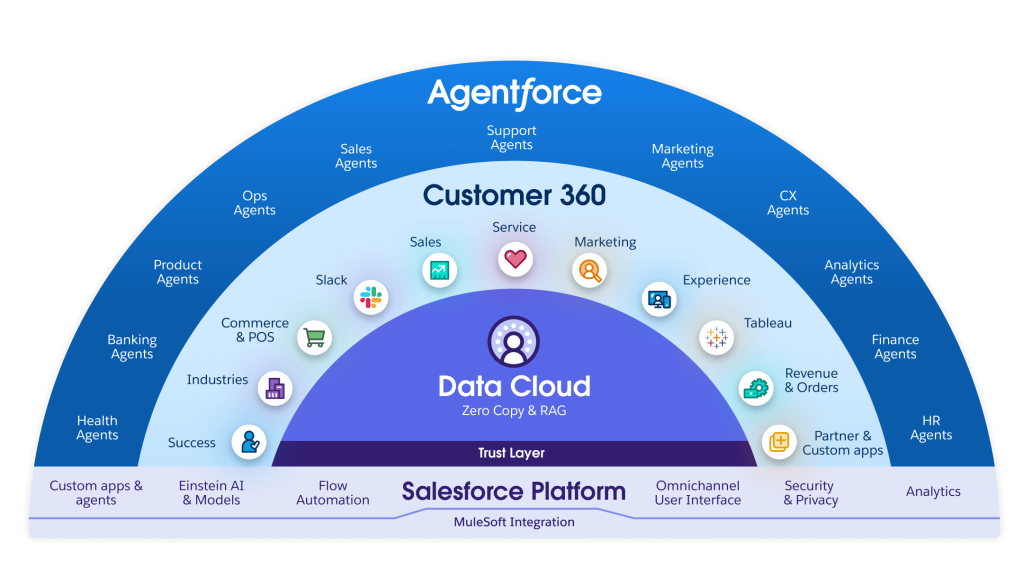
Future-Proofing: Modernization as a Launchpad for Innovation
Legacy systems modernization is the foundation for ongoing innovation. By modernizing your legacy systems with Salesforce, you position your organization to capitalize on emerging technologies and evolving business models.
Salesforce’s AI, automation, and analytics capabilities set the stage for continuous improvement. Tools like Agentforce and automation workflows empower teams to make smarter decisions faster and reduce manual work. This leads to higher productivity and new opportunities for growth.
A modular design approach means your systems can evolve over time without requiring another massive overhaul. You can add new capabilities such as self-service portals, IoT integrations, predictive operations, and generative AI as your business needs change.
The reality is clear: the sooner you modernize, the faster you unlock these innovation opportunities. Delaying modernization puts you at risk of falling behind competitors who are already leveraging next-generation technologies to transform their operations.
Partner with Gerent for your Legacy Systems Modernization
Legacy systems modernization is a critical business strategy that drives agility, efficiency, and long-term growth. Salesforce provides a scalable, secure, and future-ready foundation that empowers organizations to transform legacy systems into strategic assets.
We have partnered with numerous companies to modernize their critical systems strategically and efficiently—minimizing disruption while maximizing business impact.
If you’re ready to take the next step in your modernization journey, talk to our Salesforce modernization experts today. Discover how we can help your business modernize legacy systems without disrupting operations and position you for sustained success.








